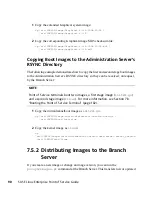
object to create a configuration file in
/srv/tftpboot/CR/
MAC
/
directories on
the Branch Server. The configuration file name is the same as the
cn
name of the re-
spective LDAP entry.
Using TFTP, the configuration file is then distributed from the Branch Server to the
appropriate Point of Services terminals at boot time.
NOTE: Assigning Configuration Files to Point of Services
The
scCashRegister
or
scPosImage
object under which the
scConfigFileTemplate
object is created determines which Point of Service
terminals receive the configuration file.
If the
scConfigFileTemplate
object is defined under an
scCashRegister
object, all terminals that correspond to the type defined in the
scCashRegister
object receive the configuration file defined in the
scConfigFileTemplate
object.
If the
scConfigFileTemplate
object is defined under an
scPosImage
object, all terminals that load the system image that corresponds to the
scPosImage
object receive the configuration file defined in the
scConfigFileTemplate
object.
Be aware that in this case, the
posAdmin
script does more than just literal in-
sertion of the data specified on the commandline. If you want to use some
other tool (e.g. GQ) to define the
scConfigFileTemplate
object, you must
directly add the configuration data themselves as the
scConfigFileData
attribute, not the path to the file containing them. Also keep on mind that the
created configuration file name is the
cn
entry of the respective
scConfigFileTemplate
object, so ensure that they are named differently
(this can be the issue when e.g., one configuration object is assigned to the
scCashRegister and the other with the same name to the scPosImage object)
Table 7.4, “posAdmin Options for
scConfigFileTemplate
Objects” (page 80)
summarizes the posAdmin command options for
scConfigFileTemplate
object
attributes.
Deploying Point of Service Terminals
79
















































